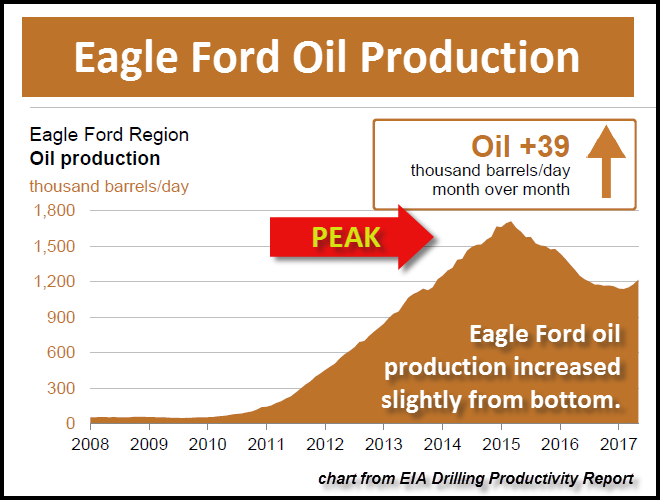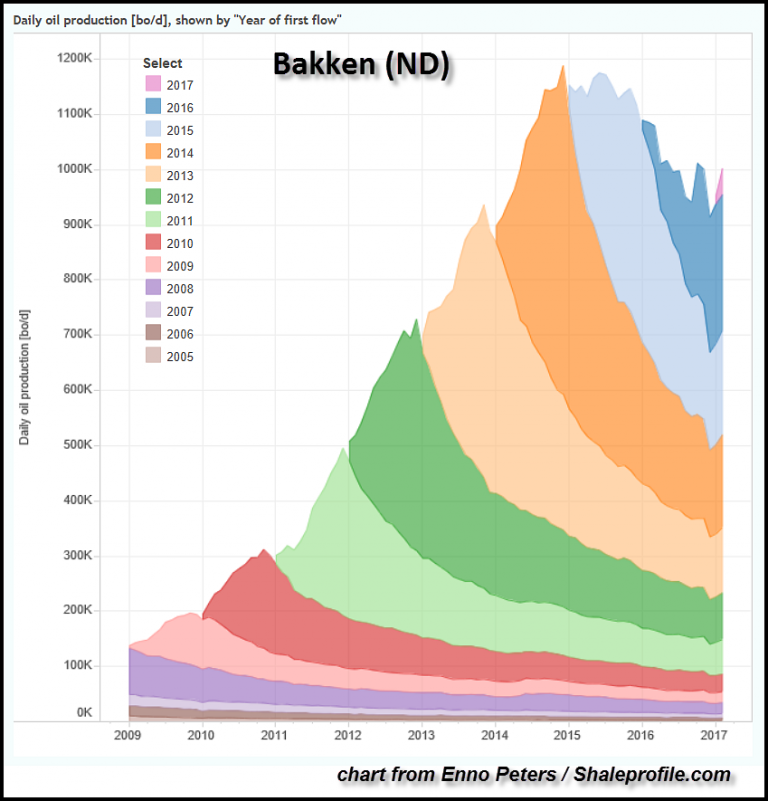The euphoria of rising U.S. oil production continues in the Mainstream media while troubling signs are now taking place at the Bakken. Even though overall U.S. oil production has climbed due an increase in drilling rig activity, supply from the Bakken has stalled.
According to the most recently released Drill Productivity Report from the EIA – U.S. Energy Information Agency, oil production at the Bakken is forecasted to decline in May:

The data from the Drilling Productivity Reports states the Bakken will add 43,000 barrels per day (bd) of new oil production in May, but its Legacy Decline will be 44,000 bd. Thus, overall oil production at the Bakken will decline a modest 1,000 bd in May. As we can see from the chart above, the Bakken’s overall trend is heading lower.
Furthermore, the peak of Bakken oil production took place at the end of 2014 at 1.2+ million barrels per day (mbd), and is now a little more than 1 mbd. You would think with an oil price now trading in the $50 range, much higher than the $30 range in the beginning of 2016, oil production would be growing once again at the Bakken. However, it is not. Actually, the Bakken was producing more oil in the beginning of 2016 when the price was in the $30’s than it is today with the price in the $50 range.
Now, the reason for the increase in U.S. oil production has largely due to the growth in the Eagle Ford and Permian Region:

The Eagle Ford in Texas is forecasted to increase its oil production by 38,000 bd in May, however its production has not increased all that much from its bottom at the end of 2016. Furthermore, Eagle Ford’s oil production is still 500,000 bd lower than its peak set in the beginning of 2015.
Now, the region in the United States that has seen its oil production increase the most, is the Permian:

Oil production growth at the Permian is estimated to increased 76,ooo bd in May. However, for the Permian to increase its production in May, it will have to add 205,000 bd of new production as its Legacy decline will be 129,000 bd. Which means, the Permian is now losing 129,000 bd of oil production each month (and this figure is growing).
The Permian is the new place where a lot of drilling and capital expenditures are now taking place. Some companies have stated they can produce oil in the Permian for $40… and even $20 a barrel in the future. It will be quite interesting to see if this takes place. While some production costs have declined, mostly due to lower oil prices and the gutting of the oil services industry, these companies aren’t going to be making the profits they used to years ago. That is a fantasy.
Troubling Signs At The Bakken
If there is one chart individuals need to see, its the Bakken oil production profile by Enno Peters at Shaleprofile.com. Enno does some excellent work on oil production data. Here we can see just how just how steep the annual declines have increased at the Bakken:

Each color represents a different year. As Bakken oil production continued to grew each year, the steepness in its declines, also increased. If we look at 2014 (in orange), we can see that production peaked at nearly 1.2 mbd. However, 2014 production would have declined to 500,000 bd (follow it down to right side of chart), if no new production was added. But, because there were new wells added in 2015, 2016 and part of 2017, production has been kept at 1 mbd.
That being said, growth died in 2015 and then declined in 2016. While it is true that the oil price was partly the blame for lower drilling rig activity in the Bakken, the steep annual decline in production was going to peak sooner or later. It just happened to be sooner. You can check out Enno Peters Bakken production profile here: North Dakota Update: Update Through Feb 2017.
Lastly, while U.S. oil production will likely increase as gains in the Permian and other areas continue, the Bakken is providing the market with a troubling sign. And that is… it’s production has stalled due to high decline rates and lower drilling activity. I highly doubt oil prices are going to increase significantly… and stay there. That is the important factor… stay elevated.
There is just way too much debt and leverage in the system propping up a highly inflated economy. When the markets crack… so will the price. This will put another nail in the U.S. oil industry coffin. As I have stated several times, I believe the U.S. oil industry will have disintegrated to a much lower level within the next 5-10 years.
Why is this bad news? Because 99% of investors who have their funds in the market, are in stocks, bonds and real estate. Those assets need a growing oil supply to keep from collapsing. Unfortunately, when oil production does decline… so will the asset values of most Americans. This isn’t a matter of decades, rather a matter of years.
